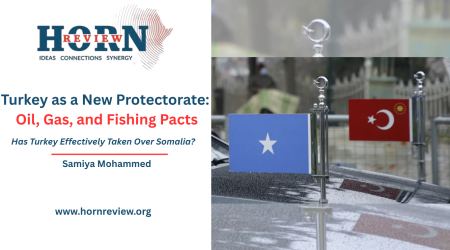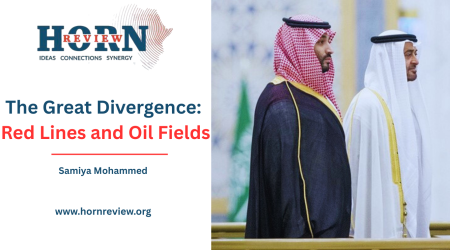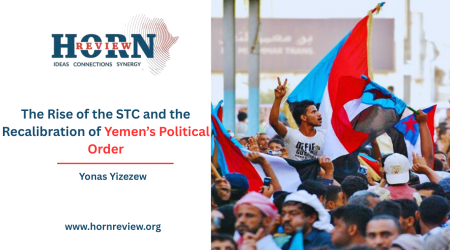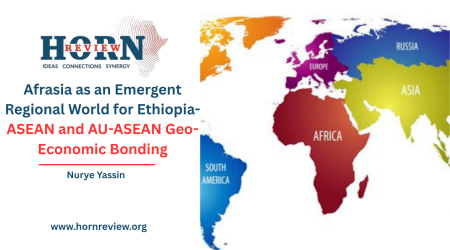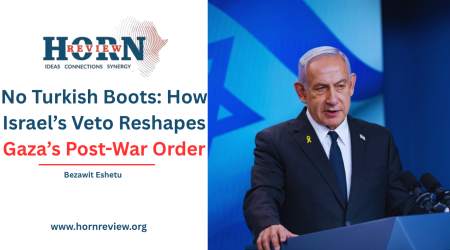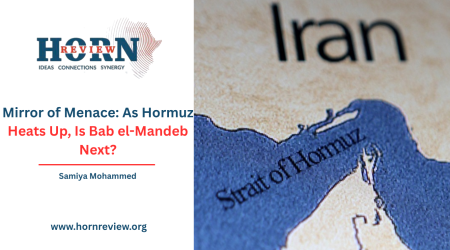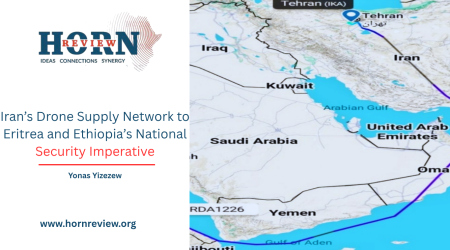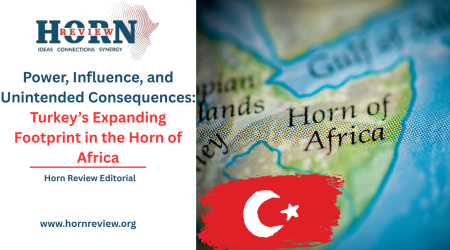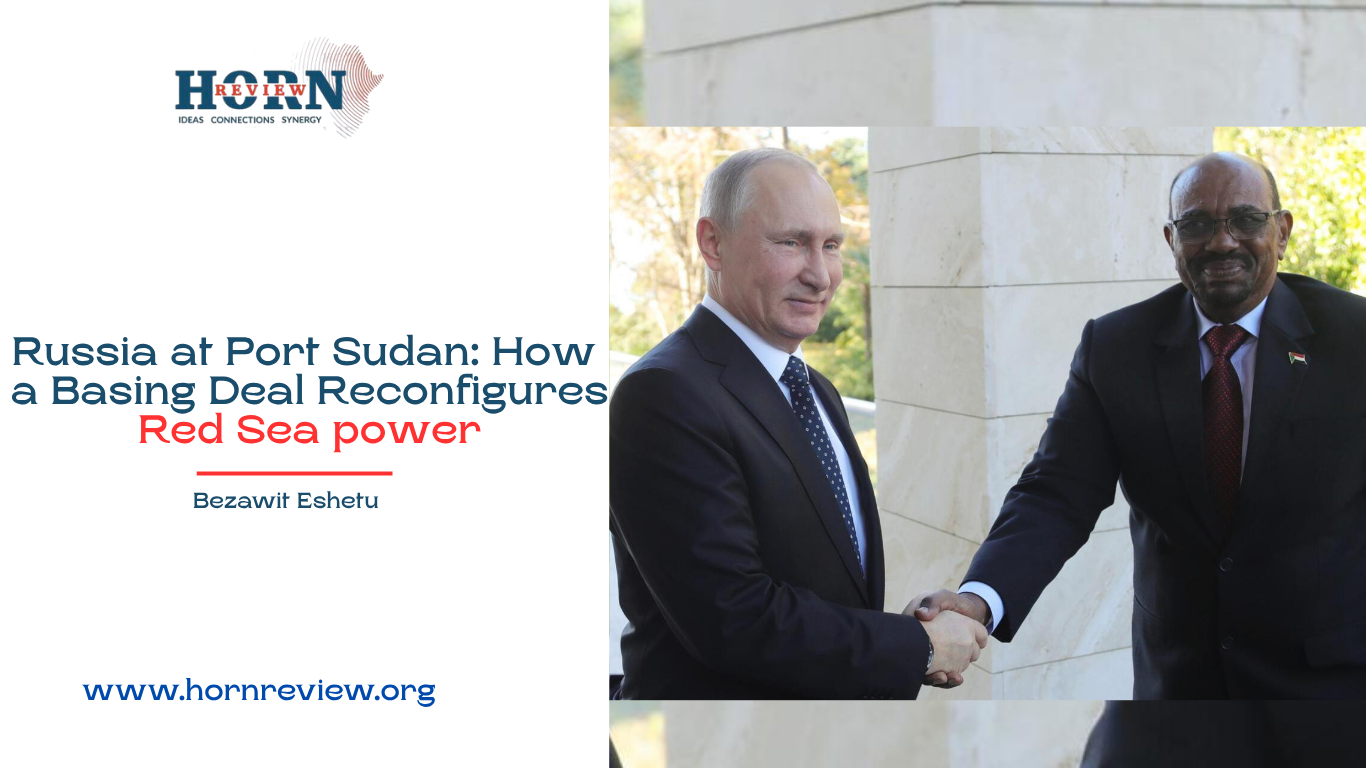
18
Oct
Russia at Port Sudan: How a Basing Deal Reconfigures Red Sea power
Moscow will host the inaugural Russia–Arab Summit in the near future, a pivotal event that is poised to redefine the dynamics between General Abdel Fattah al-Burhan and Vladimir Putin. The meeting represents the culmination of a decade of Russian designs on the Red Sea and revive a port bargain repeatedly pursued, paused and resurrected by successive Khartoum regimes. The Port Sudan project symbolizes more than just contractual agreement; it reflects the cyclical nature of, where leaders in trouble seek external patrons, transitional government exercise caution under international scrutiny, and a military authority re-endorse strategic bargains as instruments of survival.
The arc begins under Omar al-Bashir, when international isolation and domestic economic strain pushed Khartoum towards new patrons. In November 2017, Bashir met Putin in Moscow to discuss closer military and economic ties; that diplomatic exchange planted seeds for a later draft basing arrangement. Public reports from 2020–21 outlined terms for a logistics and naval support facility at Port Sudan. Key points include a 25-year lease with automatic ten-year extensions unless contested, authorization for the presence of up to 300 Russian personnel, and the capacity to host up to four warships, including the provision for nuclear-powered vessels to receive logistical support.
Those contract features matter both operationally and symbolically. Operationally, a logistics hub able to host a permanent, contingent, and multiple combatants shortens transit times for high-end Russian vessels in the Red Sea and Indian Ocean and gives Moscow a replenishment node that complements its Mediterranean presence. The facility would enable more persistent Russian presence for a range of maritime tasks; it would reduce reliance on distant replenishment and increase the tempo of deployments in a setting already crowded with foreign platforms, with implications for surveillance coverage, rules of engagement and crisis escalation. Symbolically, an overt Russian foothold in contemporary Africa would reposition Moscow from episodic influence to a physical presence on a sea lane that feeds the Suez Canal and global trade.
The agreement’s early trajectory was disrupted by Sudan’s domestic politics. After Bashir’s removal in 2019, Sudan entered a fragile transition that sought re-anchoring toward Western donors and international legitimacy. That pivot explains why Abdalla Hamdok’s government treated the Russia deal as subject to review rather than an irreversible transfer of sovereignty. In June 2021, military and civilian leaders announced a formal review, explicitly citing sovereignty and transparency concerns.
Hamdok’s posture was pragmatic. Slowing or halting the process served to break with the secrecy and patronage of the Bashir era, reassure Western partners whose financial and diplomatic support the transitional state needed, and shift major strategic deals toward parliamentary or civilian oversight. The pause did not legally withdraw earlier agreements but deferred implementation and placed the burden of ratification on future civilian institutions.
That window for civilian oversight closed with the October 2021 coup and the fragmentation that followed. Power reverted to a military sphere in which short term survival needs, access to weapons, and patronage networks regained priority. The war that erupted in 2023 intensified those incentives. Battlefield pressures and arms requirements increased the value of external backers. By 2023 and 2024, Sudanese military authorities and foreign interlocutors were renegotiating technical terms to align a basing arrangement with the post-coup political reality.
Two economic drivers shape why the lease debate returned to the table. First, Sudan’s mineral economy, especially gold, became a decisive revenue source for armed actors. Control of extraction and export routes funds militias and patronage networks. Since 2022 reporting shows a marked rise in gold production and exports despite fighting, with revenues measured in the hundreds of millions or more. Those inflows alter bargaining power and make Sudan a more attractive partner for external actors seeking both posture and resource access. Second, those revenue flows are entangled with security supply chains. Where formal finance is limited by sanctions and reputational risk, offers of arms, maintenance, and logistical support operate as practical currency. For leaders with few alternatives, a basing deal that brings a reliable patron can be presented domestically as essential to regime survival. This transactional logic helps explain why a previously paused draft agreement reemerged.
The contract agreement governing ship visits and the explicit allowance for nuclear-powered vessels is analytically crucial because it signals a host-state posture toward the full range of naval logistics. Agreements permitting landing and resupply for up to four warships, naming nuclear-powered vessels among acceptable calls, and embedding long terms with automatic renewals convert a port from episodic use into a sustained logistics node. These provisions institutionalize permissiveness and reduce the administrative friction that would otherwise limit a persistent naval presence.
Geography further reinforces the strategic logic. Situated on the western Red Sea, Port Sudan shortens the distance for vessels that would otherwise operate from the eastern Mediterranean or more distant supply chains, offering Russia forward support proximate to Bab el-Mandeb and approaches to the Suez Canal. The Suez Canal channels roughly 12% of global trade and an even larger share of container transits; secure access to the Red Sea therefore carries outsized importance for global commerce and for costal states whose prosperity depends on uninterrupted maritime flows.
This dynamic must be read against an already crowded Horn shoreline: Djibouti hosts multiple foreign facilities, China’s base being the most visible example, while Gulf and Western naval logistics operate in adjacent coasts. For regional capitals, an additional state actor embedding itself on a neighboring shoreline changes threat perceptions and alliance calculus, prompting strategic hedging and domestic political friction.
To evaluate the Hamdok pause and the Burhan revival without reducing the debate to pro- or anti-Russia, institutional sequencing and political buy-in are crucial. Hamdok’s review attempt sought to reassert domestic contestation over existential bargains; the coup and ensuing civil contest rendered that corrective incomplete because institutions that could ratify or reject the deal ceased to function in their intended civilian form.
There is a contradiction that explains the regional heat. When external states secure maritime access through bilateral bargains, it is often framed abroad as routine great-power logistics; when a landlocked neighbor or adjacent coastal state seeks mutual or compensatory arrangements, those moves are labeled destabilizing. This asymmetry in discourse inflames regional sentiment because strategic behavior is judged differently depending on whose hand signs the ledger. For Ethiopia, then, the Port Sudan file is not merely a question of Russian strategy; it confirms a pattern in which extra-regional patrons secure access with fewer legitimacy tests than domestic actors seeking redress for historical strategic vulnerability.
That vulnerability has concrete historical roots. For much of the twentieth century, Assab functioned as Ethiopia’s principal outlet to the Red Sea. Long before Eritrea’s secession in 1993, Ethiopia’s commercial and strategic lifelines depended on access through Assab, which in practice operated as the country’s maritime gateway. That historical relationship gives Addis Ababa a factual predicate for claims that are restorative rather than expansionist. Framed this way, Ethiopia’s pursuit of assured access is an effort to remedy a tangible logistical dislocation born of twentieth century sovereignty shifts rather than an assertion of revanchist intent.
The moment in which those sovereignty changes occurred was also politically complex. The sequences of federation, annexation and eventual separation unfolded amid shifting authorities and contested mandates, and transitional contexts complicated the allocation of clear, uncontested sovereign rights over port infrastructure and access. The transitional authorities at the time did not exercise unanimous, uncontested mandates across all constituencies, and that ambiguity helps explain why Ethiopia’s appeals for negotiated preference or compensated access are rooted in material and historical realities rather than simple grievance.
Those considerations intersect with contemporary Horn politics in ways that shape both perception and practicability. Coastal states already host diverse extra-regional platforms and commercial bargains; when external patrons secure long-term presence through bilateral deals those arrangements are often normalized.
In sum, as Moscow hosts the inaugural Russia-Arab Summit in the near future, the potential revival of the Port Sudan basing deal underscores a reconfiguration of Red Sea power dynamics. This event could solidify Burhan-Putin ties, embedding Russia’s naval presence amid Sudan’s survival imperatives and a crowded Horn shoreline. While granting Moscow logistical advantages near critical chokepoints, it intensifies regional asymmetries. Ultimately, great-power footholds highlight the urgency for inclusive frameworks to address historical vulnerabilities and prevent maritime instability.
By Bezawit Eshetu, Researcher, Horn Review

